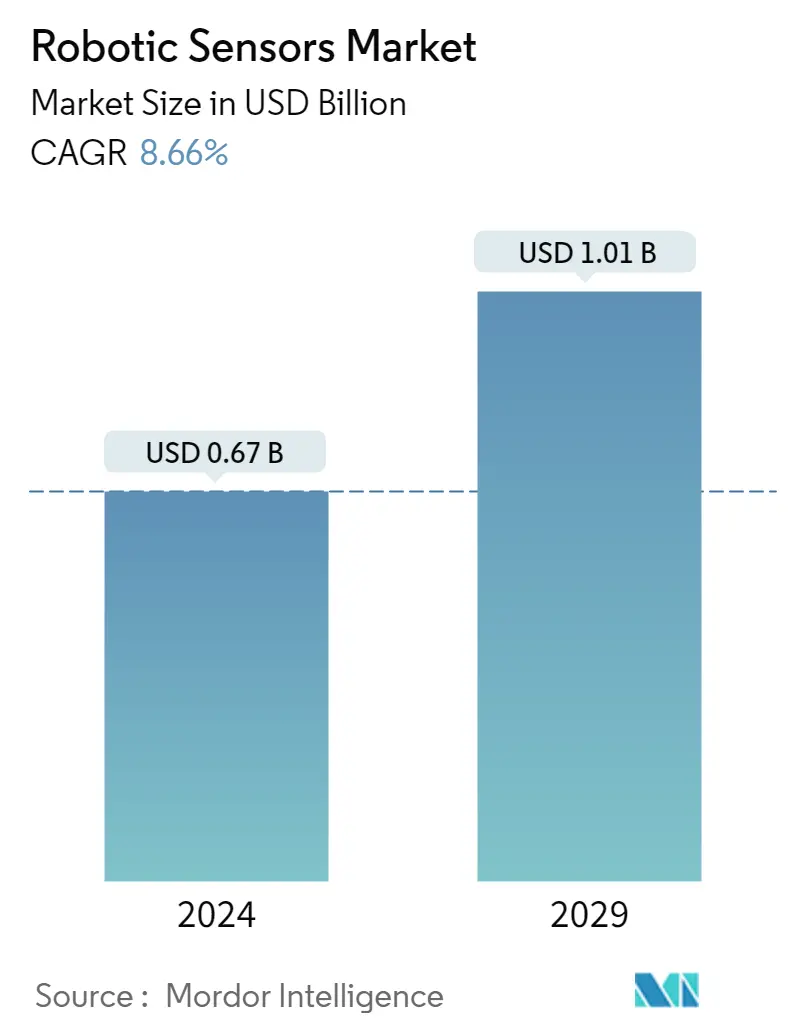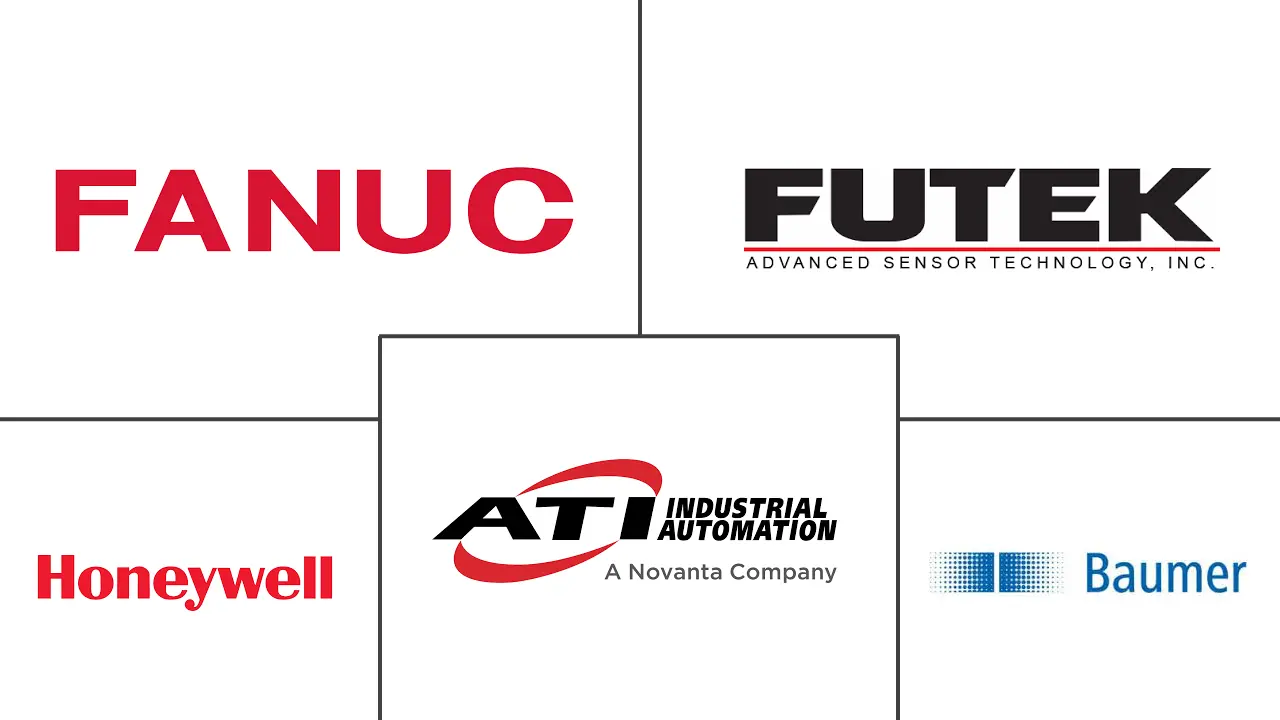Market Size of Robotic Sensors Industry

| Study Period | 2019 - 2029 |
| Market Size (2024) | USD 0.67 Billion |
| Market Size (2029) | USD 1.01 Billion |
| CAGR (2024 - 2029) | 8.66 % |
| Fastest Growing Market | Asia Pacific |
| Largest Market | Asia Pacific |
Major Players
*Disclaimer: Major Players sorted in no particular order |
Robotic Sensors Market Analysis
The Robotic Sensors Market size is estimated at USD 0.67 billion in 2024, and is expected to reach USD 1.01 billion by 2029, growing at a CAGR of 8.66% during the forecast period (2024-2029).
The market studied is anticipated to grow due to the adoption of Industry 4.0 and IIoT solutions across the various end-user industries. Also, government investments in research and development and a growing emphasis on sustainability further drive the demand of the market studied. In addition, various players in the examined market are focusing on high-growth sectors such as automotive and manufacturing to keep their business growing in the market studied.
- Many factors, including rapid technological advancements in automation, artificial intelligence, energy storage, engineering, and machine learning, drive the growth of the market. The skill shortage is the primary factor impacting the increasing adoption of robots. Coupled with the lack of labor, the rising earnings of the workforce are also influencing the demand dynamics of robots across geographies. Moreover, the workforce needs to be trained frequently to adapt to new technologies. As a result, it drives organizations to adopt robotic systems, encouraging the market vendors to innovate on the components of the systems.
- Furthermore, manufacturing in developing and underdeveloped nations is currently undergoing a constant robotic evolution. However, workers are expected to continue to enter the service business, lowering wages and resulting in job growth and pay stagnation in the service sector rather than widespread unemployment, at least in the near and medium term. The prospect of digital technologies to automate routine tasks and replace human labor can sometimes appear like an existential threat to manufacturing in developing countries. Such predictions tend to be based on technical feasibility. However, the automation of jobs also depends on economic and institutional feasibility, and these factors can outweigh the technical aspects in underdeveloped countries.
- The growing adoption of robots for automation is expected to drive the robotic sensors market. Robots are machines programmed to perform tasks and are equipped with various sensors, actuators, and control systems. These sensors enable robots to interact with their environment and perform tasks effectively. In October 2022, according to robotics research published by the International Federation of Robotics, the food and beverage industry in the United States deployed 25% more robots last year, intending to reach 3,402 units by 2021. The higher level of hygiene provided by robotics, according to IFR, may have contributed to the surge in the aftermath of the COVID-19 pandemic.
- However, a high installation cost is the primary factor challenging the market's growth. In addition, the requirement of a highly skilled workforce to operate and maintain the automation or robotics infrastructure further adds to the overall cost, restraining mass adoption, especially in small and medium-scale industries.
- With the outbreak of the COVID-19 pandemic, various pharmaceutical manufacturers increasingly felt the substantial need to react promptly to the need for hospitals and pharmacies. The COVID-19 pandemic induced restrictions that forced the companies to operate with limited labor onboard, subsequently affecting the operational capacities of the companies across the world. Several enterprises started to invest in automation technologies to overcome this labor shortage and reduce their dependence on human labor. The increasing demand for robotic systems in the pharmaceutical industry propels the need for robotic sensors, positively influencing the market studied.
Robotic Sensors Industry Segmentation
Robotic sensors are technical sensors designed for use in robotics and automation systems to measure the condition of robots and their surrounding environments. They deliver critical information to robots, enabling them to interact with the environment effectively.
The robotic sensors market is segmented by type (force and torque sensor, temperature sensor, pressure sensor, position sensor, proximity sensor, vision sensor, and other types of sensors), end user (manufacturing, automotive, process and packaging, logistics, and other end users), and geography (North America, Europe, Asia-Pacific, Latin America, and Middle East and Africa). The report offers the market size in value terms (USD) for all the above-mentioned segments.
| By Type | |
| Force and Torque Sensor | |
| Temperature Sensor | |
| Pressure Sensor | |
| Position Sensor | |
| Proximity Sensor | |
| Vision Sensor | |
| Other Type of Sensors |
| By End User | |
| Manufacturing | |
| Automotive | |
| Process and Packaging | |
| Logistics | |
| Other End Users |
| By Geography | |
| North America | |
| Europe | |
| Asia-Pacific | |
| Rest of the World |
Robotic Sensors Market Size Summary
The robotic sensors market is poised for significant growth, driven by the increasing adoption of Industry 4.0 and IIoT solutions across various sectors. This expansion is further supported by government investments in research and development and a growing focus on sustainability. Key industries such as automotive and manufacturing are attracting attention from market players, who are keen to capitalize on high-growth opportunities. The market's growth is also fueled by rapid advancements in automation, artificial intelligence, and machine learning, which are reshaping the landscape of robotic systems. Despite challenges like high installation costs and the need for a skilled workforce, the demand for robotic sensors is expected to rise, particularly in sectors like pharmaceuticals, where automation has become essential due to labor shortages exacerbated by the COVID-19 pandemic.
Regionally, Asia-Pacific is anticipated to experience the highest growth rate, with countries like China, Japan, India, South Korea, and Taiwan leading the charge in industrial robot installations. China's dominance in the market is attributed to its robust manufacturing base and government initiatives like "Made in China 2025," which aim to enhance the country's competitiveness in high-tech manufacturing. The integration of advanced sensor technologies in robotics is enabling more precise and safe operations, further propelling market growth. Global players such as Honeywell, FANUC, and ATI Industrial Automation are actively expanding their presence through strategic collaborations, aiming to capture a larger share of the market. These developments underscore the dynamic nature of the robotic sensors market, with ongoing innovations and regional initiatives playing a crucial role in shaping its future trajectory.
Robotic Sensors Market Size - Table of Contents
-
1. MARKET INSIGHTS
-
1.1 Market Overview
-
1.2 Industry Value Chain Analysis
-
1.3 Industry Attractiveness - Porter's Five Forces Analysis
-
1.3.1 Bargaining Power of Suppliers
-
1.3.2 Bargaining Power of Buyers
-
1.3.3 Threat of New Entrants
-
1.3.4 Threat of Substitutes
-
1.3.5 Degree of Competition
-
-
1.4 An Assessment of the Impact of Macroeconomic Factors and COVID-19 on the Market
-
-
2. MARKET SEGMENTATION
-
2.1 By Type
-
2.1.1 Force and Torque Sensor
-
2.1.2 Temperature Sensor
-
2.1.3 Pressure Sensor
-
2.1.4 Position Sensor
-
2.1.5 Proximity Sensor
-
2.1.6 Vision Sensor
-
2.1.7 Other Type of Sensors
-
-
2.2 By End User
-
2.2.1 Manufacturing
-
2.2.2 Automotive
-
2.2.3 Process and Packaging
-
2.2.4 Logistics
-
2.2.5 Other End Users
-
-
2.3 By Geography
-
2.3.1 North America
-
2.3.2 Europe
-
2.3.3 Asia-Pacific
-
2.3.4 Rest of the World
-
-
Robotic Sensors Market Size FAQs
How big is the Robotic Sensors Market?
The Robotic Sensors Market size is expected to reach USD 0.67 billion in 2024 and grow at a CAGR of 8.66% to reach USD 1.01 billion by 2029.
What is the current Robotic Sensors Market size?
In 2024, the Robotic Sensors Market size is expected to reach USD 0.67 billion.

